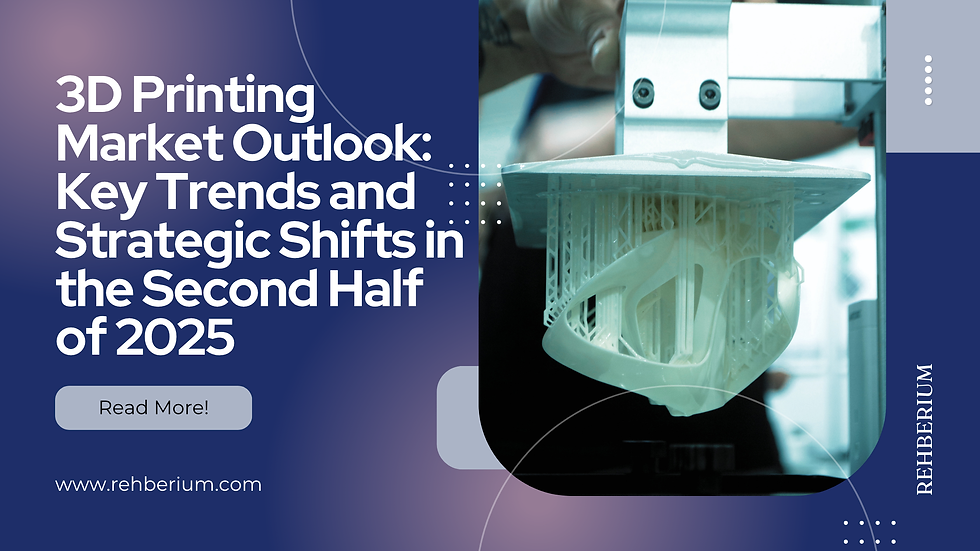State of the 3D Printing Market – June 2025
- Gökhan Gönültas

- Jun 2
- 4 min read
By June 2025, the 3D printing industry has solidified its position as a transformative force in modern manufacturing. According to recent updates from Precedence Research, the global market now stands at USD 29.29 billion, rising from USD 24.61 billion just a year earlier. Analysts continue to revise expectations upward, highlighting an ambitious climb to USD 134.58 billion by 2034—supported by an average CAGR of 18.52%.
At the same time, Wohlers Associates and AM Research reflect slightly different market sizes (USD 21.9B and USD 15.9B respectively in 2024), further emphasizing that valuation depends heavily on segmentation—consumer vs. industrial, hardware vs. services, and materials vs. software.

Why the Forecasts Differ: It’s All About the Details
Let’s clear something up—there’s no single “truth” about where the 3D printing industry is headed. Predictions vary because:
Some count only industrial hardware, others include desktop printers and on-demand services.
Definitions of materials range from polymer to bio-inks.
Some firms include software (like CAD/slicer tools), others do not.
That said, there's clear consensus on key growth enablers:
✔️ Integration of AI and machine learning
✔️ Rise of multi-material printing
✔️ Growth in on-demand manufacturing
✔️ Uptick in bioengineering and medical devices
✔️ Shift toward sustainable, decentralized production
What’s Defining the Market in Late 2025?
1. Recovery and Rebuilding
After a challenging 2024 marked by sluggish hardware sales and consolidation among AM startups, the industrial 3D printing sector has begun to rebound. Late 2025 is now being seen as the point where demand starts accelerating again—especially in aerospace, automotive, and healthcare.
2. Smart Tech: AI, Automation & Optimization
From predictive maintenance to design simulation, the use of AI in additive workflows is no longer experimental—it’s essential. Companies are embedding thermal sensors, computer vision, and automated post-processing tools to cut costs and boost part quality.
3. Healthcare’s Leading Role
Recent global surveys (like the one from Protolabs) show 77% of professionals believe the most transformative use of 3D printing is in the medical field.
Biocompatible implants
3D printed organs (yes, we’re closer than ever)
Custom orthotics and dental solutions
4. Sustainability and Circular Manufacturing
As global pressure mounts for green practices, 3D printing is answering the call:
Less waste
Localized production
Recyclable polymers and hybrid composites
Sustainability is not just a nice-to-have anymore—it’s a competitive edge.

High-Growth Sectors You Shouldn’t Ignore
Automotive
With over 25% of global market revenue in 2024, automotive remains a hotbed of innovation. Companies are optimizing designs, producing parts faster, and customizing like never before.
Aerospace
AM is the go-to tech for producing lightweight, fuel-efficient parts. Key OEMs are scaling metal 3D printing for mission-critical applications.
Healthcare
From cranial implants to surgical guides, 3D printing has entered operating rooms worldwide.
Construction
The global construction sector is experimenting with 3D-printed homes and modular buildings. Startups from the US to the Middle East are piloting eco-friendly, fast-build housing concepts.
Consumer Goods & Wearables
Eyewear, jewelry, and even sneakers—brands are embracing additive for mass customization and short-run production.
Market by Region: Who’s Leading the Pack?
North America
35%+ market share in 2024
Predicted to reach USD 34.28B by 2034
Leaders: Stratasys, 3D Systems, HP, Desktop Metal
Europe
Fastest CAGR, driven by aerospace, defense, and space exploration
Major innovation showcases at events like Formnext Frankfurt
AM startups collaborating with universities to push boundaries
Asia-Pacific
Strong government support (especially in China, India, South Korea)
Rapid rise in metal 3D printing demand
Expected to outpace other regions in adoption rate post-2026
Türkiye: The Strategic Bridge in Global Additive Manufacturing
Here’s where it gets exciting—Türkiye is uniquely positioned to play a strategic role in the global 3D printing ecosystem.
Why Türkiye Matters:
📍 Geographic advantage: At the crossroads of Europe, Asia, and the Middle East.
🏗️ Strong manufacturing infrastructure: Especially in automotive, defense, and heavy industry.
🏫 Educational momentum: Universities and R&D hubs are actively investing in additive programs.
🌐 Growing ecosystem: Local service providers, distributors, and design agencies are increasingly AM-ready.
As Rehberium, our mission is to bridge international companies with Turkish manufacturers and tech partners—unlocking partnerships that benefit from Türkiye’s competitive costs, skilled workforce, and expanding domestic market.
“Türkiye isn’t just a market. It’s a platform for scaling your additive business globally.”
Limitations & Challenges You Should Know
Even with impressive momentum, additive manufacturing faces real-world hurdles:
🕒 Still slower for large-scale production
💸 High initial capital for industrial-grade printers
🧑🏫 Lack of skilled talent in operating and maintaining equipment
🔒 Intellectual property concerns as digital files are easily replicated
🧱 Material constraints still limit adoption in some verticals
Yet, with continued R&D, educational investments, and cross-border partnerships (like those facilitated by Rehberium), these challenges are increasingly being addressed.
What Comes Next?
Here’s what to expect as 2025 wraps up:
✔️ Industrial adoption accelerates
✔️ Consumer-grade printers evolve into micro-factories
✔️ Healthcare remains the innovation leader
✔️ Türkiye continues to rise as a manufacturing and logistics hub
✔️ Sustainability and automation dominate 2026 investment plans
“The rest of 2025 will separate the 3D printing spectators from the market shapers.”

